 |
||||||||||||||||||||||||||||||||||||||
|
While meandering through the cemeteries, you
can envision the excitement and fear these early pioneers must
have felt while gathering the last pieces of life they were accustomed
to before setting off to uncharted territories in their search
for gold. What difficulties did they encountered trying to build
a new life while erecting the towns along Hwy 49, each filled
with it's own trials and tribulations. Wanting to read every tombstone,
hoping to fill in some of the blank spaces our imaginations have
created about the hardships and heartbreaks families endured while
trying to settle one of the most magnificent areas in California,
the Mother Lode, Gold Rush Country. Who were these people and
where did they come from, the people who built these impressive
places to worship, these grand homes in which to live and raise
their families. The school houses made to educate their children,
dreaming of a better life for their young ones, the reason they
traveled to these untamed areas in the first place. Because of
the many men, women and children who decided to stay in Tuolumne
County, we can enjoy the rich gold rush history through the many
buildings and cultural attractions they created out of necessity
but left behind for our enjoyment and education. Tuolumne County has many historic cemeteries.
You are encouraged to visit each and every one of the cemeteries
in Tuolumne County, for historical study, genealogical research
or to travel back in time while enjoying a walk today. Please
be respectful of those buried there, do not remove any items and
because of the fragile nature of the tombstones please do not
disturb them.
• Sonora Fire Department
Museum - 94 N. Washington St. (above City Hall) Experience
over 100 years of firefighting in Sonora through a collection
of photographs uniforms and other memorabilia. Vintage
equipment also on display. Hours: 9am - 5pm daily.
• St. James Episcopal
Church Museum - Snell
St. at Wyckhoff St. (upstairs in social hall)
A carefully displayed history of the "Red Church.
Hours: 9am - 5pm - Monday - Friday. Stop
by church office first • Tuolumne County Museum
and History Center - 158 W. Bradford St. - 209-532-1317
Delight in the rich history of Tuolumne County housed in
what was once the old county jail. Hours:
9am - 4:30pm - Monday - Friday. Open weekends from Memorial
Day through Labor day 10am - 3:30pm. • Tuolumne City Memorial
Museum - Carter and Bay Streets - 209-928-3516 Open
Saturday and Sunday - 1pm - 4pm or by appointment. • Veterans Memorial Hall
and Military Museum - 9 N. Washington St. - 209-533-0923
Open Monday - Friday 10am - 2pm - Saturday 11am - 3pm • New Melones Visitors
Center and Museum - 6850 Stud Horse Flat Rd. - 209-536-9094
The museum displays natural and cultural history. General
information on recreational facilities. Ongoing public programs.
Sponsored by Department of Interior and Bureau of Reclamation. It was March 27, 1850 when gold was discovered
in Columbia by Dr. Thaddeus Hildreth, his brother George and a
small group of prospectors. Or was it a group of Mexicans who
panned for gold in the same spot in secrecy for four or five months
prior to the Hildreth party happening upon them? According to
most reports the Hildreth party discovered gold in Coumbia. Like
all the Gold Rush
• Columbia State Historic
Park - 22708 Broadway St. - 209-532-4301
Known as the best preserved Gold Rush town in
California. Knowledgeable guides staff the park museum and
lead daily walking tours through blocks of restored brick
buildings, all circa 1850-1870. Many special events occur
year round. Admission is free • Columbia Museum
- Main and State Streets - 209-532-4301 You will find Groveland on your way to Yosemite
National Park on Hwy.120. You can still see the remnants of this
once prosperous Gold Rush Town in the historic buildings still
in use today. Originally named Savage's Diggings after James Savage
who discovered gold there in 1848. By 1850 the town was named
Garrotte for its swift and harsh justice. By the 1870's , Garrotte
had become a quiet village catering to cattle ranches and a few
tourist on their way to Yosemite. In 1875, Ben Savory, owner of
what is now the Groveland Hotel, convinced those of Garrotte to
rename the town Groveland. Now Groveland is a delightful tourist
destination where you can take day trips to Yosemite and other
nearby points of interest. Enjoy an abundance of recreational
activities including golf, water sports, horseback riding, biking
and much more. Shopping, unique stores filled with history, fine
dining, art galleries just to name a few of the activities to
explore while in Groveland.
• Groveland
Museum/Library -
18990 Highway 120 - 209-962-0300
• Jimtown 1849 Gold Mining
Camp - Jamestown Rd. off Hwy 108/49 - 209-984-4653 Jimtown
sits on the site of a former Gold Rush camp along historic
Woods Creek, where gold was first found in Tuolumne County
in 1848. Experience life in a simulated 1849 gold camp.
Open daily 9am - 5pm. • Bearcloud Gallery
- Main St. - 209-984-4244 This gallery features works in
all media by local Native American and Western artists.
Open Thursday - Monday - 12 Noon - 5pm • Railtown 1897 State
Historic Park - 5th Ave. and Reservoir Road - 209-984-3953
Built as the headquarters of the Sierra Railway, a short
line that still serves the area today. You will see the
only surviving original roundhouse west of the Mississippi.
Purchased by the State of California in 1982 to become a
State Historic Park and part of the California State Railroad
Musseum. The depot store, interpretive center, roundhouse
and grounds are open daily from 9:30am - 4:30pm year round.
You can ride an authentic steam train over part of the historic
railroad Saturdays and Sundays, April through October and
Saturdays in November. Enjoy a six mile, 40 minute roundtrip
ride narrated by knowledgeable car attendants. The Sierra
Railroad has been featured in more than 200 movies, television
shows and commercials since 1919. Call for fares and special
excursions. Yosemite was originally the Native American
word "Uzumati," which means grizzly bear. One of the most visited areas in the world
and rightfully so. Unbelievably scenic panoramas will delight
your every sense as you descend into Yosemite Valley. Nature has
provided an amazingly beautiful area for our visual pleasures
as well as a myriad of recreational opportunities. Sensational
rock formations such as El Capitan, Half Dome, Sentinel Rock and
Bridal veil Falls are breathtaking. Choose from hiking, rock climbing,
mountain biking, fishing, horseback riding, water sports, golfing,
alpine skiing, ice skating, sleigh rides, snowmobiling, snowshoe
walks and camping amid the natural beauty of dense forests and
wide open meadows. Recreation is only one of the many activities
Yosemite provides. A variety of special events take place year
round for your enjoyment and shopping for antiques, in specialty
shops, visiting art galleries, cultural attractions, and fine
dining are sure to delight the senses. This and much more make
Yosemite a must on every vacationers list of important places
to see.
• Highway 120 - The
Northern Yosemite Highway Park information and roads - 209-372-0200 • Yosemite Mountain Sugar
Pine Railroad, which recreates the old logging steamers,
taking modern-day visitors on a four-mile excursion through
the forest. • Wawona's Pioneer Village
- a 19th century historical site, hosted by folks in period
costume from mid-June through Labor Day and at Christmas.
Info: 209-375-6391 • Mariposa Grove
- visit the Grizzly Giant, the oldest known giant sequoia
in the world, with a diameter of 35 feet and a circumference
of more than 100 feet. The grove has 250 awe-inspiring giant
sequoias, the largest trees on earth many of which are nearly
3,000 years old. • Tunnel View - one
of the most photographed vistas in the world. • Glacier Point -
one of the most spectacular overlooks anywhere. 3,214 feet
above the Valley floor. |
Home | Hwy 49 Map | Cities Directory | Business Directory | Bed & Breakfast | Golf Courses | Wineries | Historic Churches
Gold Rush History | Historic Photo Gallery | Gold Facts | We The People | Ghosts | General Store | Old Sac | Tahoe | Yosemite
historichwy49.com
Since 1999
© 2000,
2001, 2002, 2003, & 2004 historichwy49.com
e-mail: info@historichwy49.com
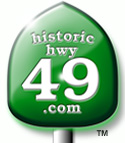

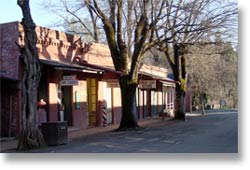
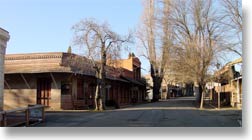 camps
along the Mother Lode, with the discovery of gold came a deluge
of miners, and a town was born called Hildreth's Diggings, the
name was changed two more times, once to American Camp then to
Columbia, all in 1850. Columbia was California's second largest
city at the time of the Gold Rush. By the end of 1852 Columbia
had over 150 stores, shops, saloons and other businesses, a Masonic
lodge, a Sunday School, and a branch of the Sons of Temperance.
Today Columbia is a State Historic Park in perfectly restored
condition to its 1850-1870 era
camps
along the Mother Lode, with the discovery of gold came a deluge
of miners, and a town was born called Hildreth's Diggings, the
name was changed two more times, once to American Camp then to
Columbia, all in 1850. Columbia was California's second largest
city at the time of the Gold Rush. By the end of 1852 Columbia
had over 150 stores, shops, saloons and other businesses, a Masonic
lodge, a Sunday School, and a branch of the Sons of Temperance.
Today Columbia is a State Historic Park in perfectly restored
condition to its 1850-1870 era 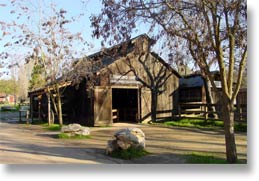 appearance.
Considered the best preserved gold rush town along the Mother
Lode. Columbia, the "Gem of the Southern Mines," is a living museum.
Staffed with knowledgeable guides you will enjoy a walking tour
through blocks of brick buildings. Experience gold panning, ride
a 100 year old stagecoach. Try a sarsaparilla at an 1850's saloon.
Delight in a melodrama or a full stage production at the Fallon
House Theatre. Explore the museums and antique shops. See unique
shops where costumed craftsmen and artisans demonstrate skills
from the Gold Rush Era. The town also hosts many special events
that bring the era to life, including candlelight processions
at Christmas. Shopping, horseback riding, fine dining, many cultural
experiences and more await you at Columbia State Historic Park.
appearance.
Considered the best preserved gold rush town along the Mother
Lode. Columbia, the "Gem of the Southern Mines," is a living museum.
Staffed with knowledgeable guides you will enjoy a walking tour
through blocks of brick buildings. Experience gold panning, ride
a 100 year old stagecoach. Try a sarsaparilla at an 1850's saloon.
Delight in a melodrama or a full stage production at the Fallon
House Theatre. Explore the museums and antique shops. See unique
shops where costumed craftsmen and artisans demonstrate skills
from the Gold Rush Era. The town also hosts many special events
that bring the era to life, including candlelight processions
at Christmas. Shopping, horseback riding, fine dining, many cultural
experiences and more await you at Columbia State Historic Park.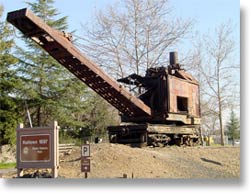 Jamestown
is near the spot where gold was first discovered in Tuolumne County.
It was Rev. James Woods that discovered gold on Woods Creek in
1848. It wasn't long that the first gold seekers left the area
and Jamestown slumbered until 1896 when a group of Bostonians
purchased the Whiskey Hill Consolidated Gold and Silver Mining
Co. and opened it as the Harvard Mine a year before the railroad
came to town. Now with the new mine and railroad Jamestown was
booming again. Today you can ride an authentic 1890's steam train
for a ride over part of the historic Sierra Railroad. The Railtown
complex, built as the headquarters of the historic Sierra Railroad,
is the only surviving original roundhouse west of the Mississippi.
Historic downtown Jamestown offers something for everyone. Shopping
down main street for antiques, gifts, clothing, and specialty
items is an experience of its own. Fine dining, cultural attractions,
historic bed and breakfasts, nearby wineries and golf courses
as well as recreational activities are reasons to visit historic
Jamestown
Jamestown
is near the spot where gold was first discovered in Tuolumne County.
It was Rev. James Woods that discovered gold on Woods Creek in
1848. It wasn't long that the first gold seekers left the area
and Jamestown slumbered until 1896 when a group of Bostonians
purchased the Whiskey Hill Consolidated Gold and Silver Mining
Co. and opened it as the Harvard Mine a year before the railroad
came to town. Now with the new mine and railroad Jamestown was
booming again. Today you can ride an authentic 1890's steam train
for a ride over part of the historic Sierra Railroad. The Railtown
complex, built as the headquarters of the historic Sierra Railroad,
is the only surviving original roundhouse west of the Mississippi.
Historic downtown Jamestown offers something for everyone. Shopping
down main street for antiques, gifts, clothing, and specialty
items is an experience of its own. Fine dining, cultural attractions,
historic bed and breakfasts, nearby wineries and golf courses
as well as recreational activities are reasons to visit historic
Jamestown